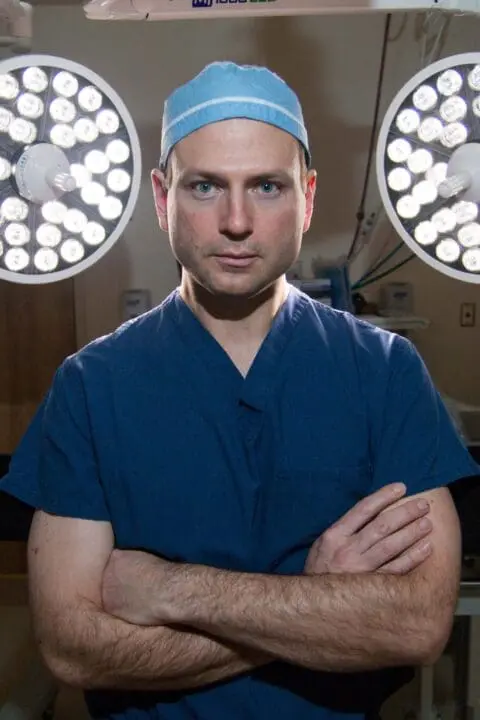Pelvic & Acetubular Fractures
Pelvic and acetabular fractures are serious injuries caused by a traumatic incident such as a motor vehicle accident or a bad fall and can affect anyone, regardless of age. The pelvic and acetabular regions are mechanically important to the human body and adjacent to important anatomic structures. An injury sustained to these areas is inherently dangerous.
Therefore, pelvic and acetabular fractures should be treated by surgeons with expertise operating in the pelvis. Los Angeles’s Dr. Daniel C. Allison’s extensive experience in the treatment of pelvic tumors of bone and soft tissue and pathologic pelvic fractures makes him exceptionally qualified in handling these challenging fractures with relative ease.
In addition, some elderly patients with fragile bones due to osteoporosis develop pelvic and acetabular fractures from a lower impact fall. These structures are the central foundation of the skeleton and when they are injured, it can become a potential source of long-term disability and may even be life threatening.
As an orthopaedic trauma surgeon, Dr. Allison intervenes with rapid and precise treatment which these types of injuries require and improves outcomes for patients from these potentially devastating injuries in order to promote limb preservation.
Symptoms from Traumatic Injury
When skeletal fractures occur from traumatic injury such as an accident or fall, there can be internal bleeding from the broken bone and the surrounding injured soft tissues. Bleeding will be severe if the blood vessels are torn. Traumatic injury could also damage internal organs, such as the bowel or bladder, and impair nerves with the patient losing sensation and muscle function.
Severe injuries to the pelvis can be life-threatening, especially if there are several breaks. This type of injury can cause shock, extensive internal bleeding and internal organs damage. The immediate goal is to control bleeding and stabilize the condition.
Musculoskeletal Complexity and Pelvic Acetubular Fractures
Pelvic fractures may occur at any location of the bones depending on the nature of the accident and the areas of impact. Pelvic and acetabular structures are complex and for best results require an orthopedic specialist like Dr. Allison.
The pelvis rests on the hip joint and is made up of several bones (ischium, ileum, and pubic bones) which together meet in the front and the lower end of the spine at the back (sacrum). The bones of the pelvis support the upper body’s weight with the help of ligaments and muscles. The pelvis protects abdominal organs, including the intestines and the bladder, as well as major nerves and blood vessels.
The acetabulum is a component of the pelvis forming part of a hip joint. The acetabular is the “socket” of the hip joint, and a fracture occurs when this socket is broken. These types of fractures are much less common than most hip fractures, which typically affect the “ball” of the joint (the very top of the femur bone).
Diagnosis & Treatment of Pelvic Acetubular Fractures
Numerous sources are used to help in developing a treatment plan for these types of fractures. Dr. Allison uses information gathered through a thorough physical examination, X-rays, and CT scans. If bone displacement and incongruity have damaged the pelvis or acetabulum, Dr. Allison recommends surgery.
There are multiple goals of fracture surgery, including:
-
- Restoring the pelvis’ or acetabulum’s normal shape
- Minimizing post-traumatic arthritis
- Decreasing pain and improve mobility
- Avoiding or delaying total hip replacement
A fracture of the pelvis or acetabulum is typically not life-threatening for 80-85% of patients. For a good to excellent recovery, you want to select an orthopedic surgeon like Dr. Allison who has superior expertise in making sure the hip is properly aligned and fixed.
Surgical Precision is Critical
Treatment is based on a number of factors including the type of fracture, pelvic stability, and the degree of bone displacement. Patients with acetabular and pelvic fractures often have displacement making re-alignment necessary. One of the most crucial steps of surgery is lining up cartilage and bone to prevent joints from rubbing together otherwise problems, such as severe joint arthritis, loss of motion, decreased function and pain could develop.
Surgery achieves the objectives of:
-
- Stabilizing the hip
- Aligning the cartilage surface
- Removing bone debris from within the hip joint
Surgery is performed to put pelvic bones back together and hold them in place with an internal device. In cases with traumatic acetabular fracture, Dr. Allison corrects cartilage displacement and hip damage. Along with extensive surgery, these injuries require lengthy physical therapy and rehabilitation.
Dr. Allison only recommends surgery when it is the best method to restore optimum functionality.
Read more about pelvic and acetabular fractures from ncbi.gov.



